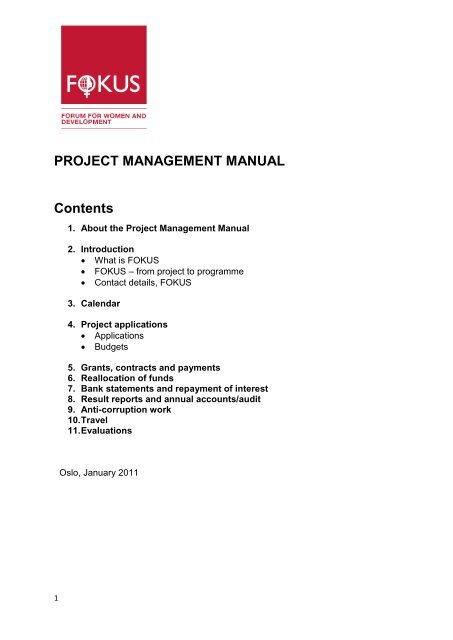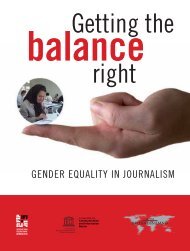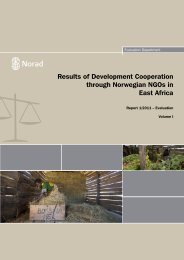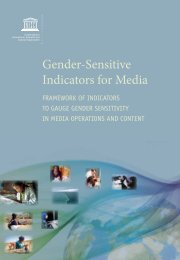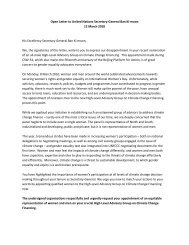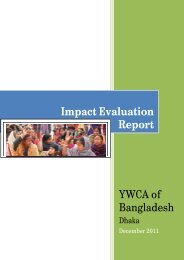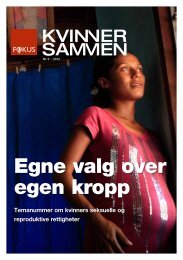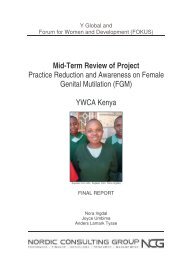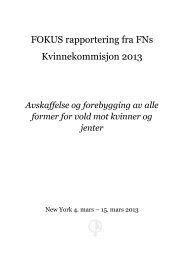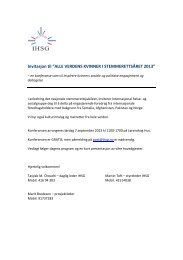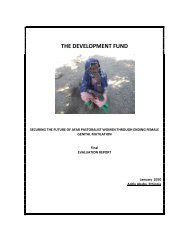PROJECT MANAGEMENT MANUAL Contents - Fokus
PROJECT MANAGEMENT MANUAL Contents - Fokus
PROJECT MANAGEMENT MANUAL Contents - Fokus
- No tags were found...
You also want an ePaper? Increase the reach of your titles
YUMPU automatically turns print PDFs into web optimized ePapers that Google loves.
<strong>PROJECT</strong> <strong>MANAGEMENT</strong> <strong>MANUAL</strong><strong>Contents</strong>1. About the Project Management Manual2. Introduction What is FOKUS FOKUS – from project to programme Contact details, FOKUS3. Calendar4. Project applications Applications Budgets5. Grants, contracts and payments6. Reallocation of funds7. Bank statements and repayment of interest8. Result reports and annual accounts/audit9. Anti-corruption work10. Travel11. EvaluationsOslo, January 20111
1. ABOUT THE <strong>PROJECT</strong> <strong>MANAGEMENT</strong> <strong>MANUAL</strong>FOKUS has made this manual as a tool for organizing project and program work, anaid to help organizations systematize their project management and simplify theadministrative follow-up.The manual contains explanations of the entire project cycle. The information isorganized chronologically, beginning with the preparation of applications and endingwith the presentation of the annual report and accounts. Sections concerning projecttravels, evaluations etc are also included. New project co-workers must be madeaware of the manual and kept up-to-date on project work that is in process.Templates will be available on FOKUS‟ web portal –members‟ area. All templateswill be available on Petrus project management tool, as it is gradually beingimplemented.2
2. INTRODUCTIONWhat is FOKUSFOKUS – Forum for Women and Development – is a knowledge and resource centerfor international women‟s issues with an emphasis on the spreading of informationand women-centered development cooperation. As of January 2011, the organizationconsists of 74 women's organizations and women's committees in political parties,trade unions, and solidarity and aid organizations. FOKUS receives financial supportfrom the Norwegian Agency for Development (NORAD) and the Ministry of ForeignAffairs (MFA) through framework agreements on development and informationactivities.In 2005, FOKUS was the beneficiary of the Norwegian national television‟s Telethon,whose funds have gone to combating violence against women.FOKUS’ vision isA just world where the organizing of women serves as the foundation for equalsocieties without oppression.FOKUS’ main goal is;To work for an improvement of women’s social, economic and political situationinternationally, with an emphasis on the countries in the South 1 .”<strong>Fokus</strong> shall: be the competence and resource center for women‟s organizations oninternational women‟s issues.through development cooperation, strive to improve the social, economic andpolitical situations of women internationally with an emphasis on the countries inthe South.through information work, strive to increase Norwegian society‟s knowledge aboutand understanding of women‟s situation and role in a development perspective.aim to strengthen the bonds and collaboration between Norwegian women‟sorganizations in their international efforts.FOKUS activities coordinate women‟s organizations‟ project cooperation in Africa, Asia, theMiddle-East and Latin-America. administer support to women‟s organizations‟ information activities. organize seminars and conferences. promote women‟s rights in national and international forums, to ensure theimplementation of women‟s rights internationally. coordinate preparations for international conferences and ensure activenetworking nationally and internationally.FOKUS‟ work is primarily based on the UN Convention on the Elimination of AllForms of Discrimination against Women (CEDAW), and the Beijing Platform forAction adopted by the Fourth World Conference on Women in Beijing in 1995.1 Countries in “the South” include poor and marginalized countries that, according to the OECD, may receive aid. They aremostly located on the southern hemisphere. Greater parts of Africa, Asia, Latin America, Eastern and South-Eastern Europe areincluded in the term.3
FOKUS‟ approach in general is rights-based, and this affects all areas of its work. Inorder to contribute to improve women‟s situations in the strategy period, FOKUS willgive priority to the following themes:Women‟s rightsViolence against womenWomen in and after war and conflictWomen‟s political and economic participation4
FOKUS – from project to programmeProject/ programme co-operation forms a central part of FOKUS‟ activity and is run incooperation between Norwegian member organizations and partner organizations inAsia, Africa and Latin America.During 2008, FOKUS initiated a process with its member organizations and southpartners to move from a project-based to a program-based approach. The point ofdeparture for the program-approach is that smaller projects are grouped together inlarger programmes based on various joint criteria, such as target group, theme,geographic area or work methods. A program must be based on a joint programstrategy, which for a country will typically be a country strategy. The advantages ofgrouping several projects in a program are various. Working in fewer, largerprograms, rather than many smaller projects, makes it easier to develop a jointanalysis and strategy, which will be the basis for actions at both programme andproject level. Furthermore, it will be easier to capture the synergies between projectsand obtain better results in, for example, a programme country, if a joint „addedvalue‟ from joining into a program is found.A programme can be formed based on a member organization‟s projects within atheme or region, or all FOKUS financed projects in a geographical area or within atheme. In the first alternative the member organization will submit a programmeapplication where the joint programme strategy is set down. Looking at the secondalternative, a joint strategy for the theme / geographic area which forms the point ofdeparture for the programme (e.g. a country strategy) is made and each organizationsubmit a project application as normal. The joint strategy is formulated by the southpartners together with the member organizations, with support from the FOKUSsecretariat. It is important that individual projects clearly show how they relate to themain programme.There will often be expenses related to the implementation of measures at theprogramme level. In order to address this in a practical way, it is suggested that oneof the partners in the programme include the costs of implementation of activities atthe programme level in its project budget, reporting this in the usual way as a part ofthe project. This task will rotate between the partners in the programme.The projects are spread in various countries in Africa, Latin America, Asia and theMiddle East. Projects in Eastern and Southern Europe are being phased out, incompliance with 2007-2012 strategy‟s geographic priority. FOKUS also supportsseveral global and regional women‟s networks.More information concerning FOKUS organizations‟ joint visions and aims for its workcan be found in FOKUS‟ Strategy and Project Strategy on our website.FOKUS policies on each of the four thematic priority areas can also be found on theweb site. These are crucial as the define what types of acitivities that fall withinFOKUS‟ mandate.Information concerning FOKUS‟ projects can also be found on the website.5
Contact details, FOKUSFOKUSStorgt. 11, 0155 OSLOTlf.: 23 01 03 00Fax: 23 01 03 01fokus@fokuskvinner.nowww.fokuskvinner.noPhone and e-mail addresses to the secretariat:Gro Lindstad tlf: 95 05 45 87General Managergl@fokuskvinner.noMette Moberg tlf: 911 98 252Head of Finance and administration mm@fokuskvinner.noTrine Tandberg tlf.: 414 40 809Head of communicationtt@fokuskvinner.noMarit Sørheim tlf.: 900 67 826Head of Programms@fokuskvinner.noMarianne Jorddal tlf.: 924 29 555Adviser, administration and finance mj@fokuskvinner.noMagnus Holtfodt tlf.: 971 42 952Assistant, administrationjrp@fokuskvinner.noSissel Thorsdalen tlf: 928 42 067Program adviserst@fokuskvinner.noAnton Popic tlf: 454 02 984Program adviserap@fokuskvinner.noJon Rian tlf.: 930 89 918Program adviserjr@fokuskvinner.noAnita Sæbø tlf.: 938 34 542Program adviseras@fokuskvinner.noCarolina Maira Johansen tlf.: 959 38 968Adviser, program oncmj@fokuskvinner.noimplementation of SCR 1325 inColombia and Sri LankaHelene Langsether tlf.: 971 71 191Adviser, analysis and assessment unit hl@fokuskvinner.noTore Skarvang tlf: 464 25 896Accountantskarvang@online.no*FOKUS’ office in COLOMBIAAdress: Carrera 27 A # 40 A 68. Barrio La Soledad.Tel: +57-1-3378341 or +57 313 456 56 20Ana Milena González V. tlf: +57 3102738203Projectcoordinatoramg@fokuskvinner.noSandra Masso tlf: +57 313 841 53 65Adviser administrationfkvsmo@plugg.no6
3. CALENDAR 2011CLOSING DATES20 January Repayment of accumulated interest from the previous year, with bankstatement from 31.12, which shows accumulated interest. The interestis to be transferred to the following accounts:TV-funds: 8200.06.03569, Norad funds: 1607.35.44851February/MarchJanuaryMarchContract signed for Norad (dependent on when the letter of approval isreceived from Norad) and TV campaign funded projects. Contractmeetings with all project organizationsReceive first project payment (60%) TV-campaign fundsReceive first project payment (50%) for Norad funds15 March Send FOKUS a written result report (set template in Petrus projectmanagement tool) and audited accounts: The project‟s accounts areaudited by an auditor in the project country and subsequently theNorwegian organization‟s auditor audits all transactions in and out ofthe Norwegian account, to ensure correctness. The followingdocuments are to be submitted to FOKUS together with the narrativeand accounts report: Audited accounts from the project partner with local declaration ofaudit (from the country where the project is to be implemented) Audited total accounts for the project from the project partner, if theproject has several contributors Control sheet using set Excel-template Norwegian audit declaration or a copy of the Norwegian bankstatements/transfer vouchers or other vouchers Simple overview of what the administrative support (8%/5%) hasbeen used for15 August Reallocation: Closing date for submission of half-yearly accounts inFOKUS‟ template for budgets and accounts, and an overview ofexpected total expenditure for the whole year for eachprogramme/project. The last named overview is to be submitted onFOKUS‟ reallocation form.In cases of under spending and applications for extra funds a revisedbudget is to be submitted, with orientation as to which items have beenchanged. This applies for both TV- and Norad funds.July/AugustReception of second project payment from FOKUS (50% for Noradfundedprojects, 40% for TV-campaign-funded projects). Thispresupposes that the audited accounts from the previous year havebeen submitted and approved by FOKUS and Norad, and that FOKUShas received copies of signed contracts between Norwegian memberorganizations and south partner.1 September Closing date for applications for the following year to FOKUS.7
Project partner to be included in planningThe project partners must receive an adapted version of the calendar so all areaware of what must be done and when. The project partner should have an earlierclosing date than the Norwegian organization to enable it to submit its reports, halfyearlyoverview and applications in time. The timetable set up with project partnerscan vary from that decided by FOKUS as long as the closing dates set by FOKUSare complied with.The last payment to the project must take place before 1 December in the projectyear.4. APPLICATIONS/BUDGETSApplicationsOrganizations which are affiliated to FOKUS can apply for funds on behalf oforganizations in the South. Projects must be initiated and applications formulated byorganizations in the South, in compliance with their premises. It is a requirement thatthere is an organization from the south that will operate the project. Applications mustbe in accordance with FOKUS‟ strategy, project strategy and policy for each of thefour thematic priority areas. If a FOKUS member organization receives applicationsfrom several partners in the same geographical and/or subject area, the possibility ofincorporating these into one application to FOKUS should be considered.Information on funding through FOKUS is available in April/May for the followingyear. This means that organizations have over three months to collect annual plans,budgets etc for the next year. It is important to start this work early.The forms are submitted by using Petrus project management tool via Internet. Eachproject and programme has its own link to the application form, which is distributedby the FOKUS secretariat to the organizations that wish to apply. Contact FOKUS ingood time before an application is made.All organizations have submitted a three-year application (2010-2012). For 2012 (aswas the case for 2011) it is only necessary to subit changes in the activity form (LFAmatrix) and an updated budget for 2012.The closing date for project applications to FOKUS is1 September.This date must be complied with.The application must be submitted in English.The application must include a budget in FOKUS‟ budget template (see next page).The application must be approved by either the project committee or the board of theNorwegian member organization.8
The budget processBudgets from the project partnersSouth partners set up a budget proposal in their local currency (e.g. South Africanrand) and/or the foreign currency which is most used in the country (e.g. US$). Abank can be contacted to obtain an indicator for the expected currency rate for thecoming year. The average rate for the previous year can be found on the web site ofNorges Bank (The Bank of Norway), www.norgesbank.no. FOKUS provide a rate indollars and euro in connection with funding information which is to be used by all.FOKUS‟ budget and accounts template must be used, see guide lines for completionof the form (to be found inside the form itself, last page).It is important that the budget reflects, and is in relation to, the results and activitiesdefined in the project application.The funding from FOKUS is often only a part of the total budget, therefore it isimportant that the budget and plans for the project‟s total activity is clear. The totalbudget for the whole project must also clearly show if the Norwegian organizationfunds the project or organization together with other contributors.FOKUS shall receive the local co-partner‟s budget for the organization‟s total activity,where the various donors‟ contributions are specified.Budgets in Norwegian crownsSome project expenses in Norway are included in the budget (e.g. project travel andsupport for audit in Norway, see own box). Other expenses which accumulate inNorway in connection with the follow up of the project are to be covered by anadministrative remuneration. This is calculated only from the sum applied for fromFOKUS (90%) and not from the own contributions.5. GRANTS, CONTRACTS AND PAYMENTSThe <strong>Fokus</strong> board approves applications at a board meeting in October, onrecommendation from the secretariat. The organizations will then receive a letter withthe board‟s recommendation regarding the grant per project.Norad‟s answer is usually given in February/March.ContractsA contract will be entered into between FOKUS and the Norwegian projectorganizations to ensure that all comply with their obligations. A contract meeting willbe arranged as soon as FOKUS has received the approval from Norad. Projectsfinanced by TV –campaign funds have contract meetings in January.The contract includes the main contract with grant andEnclosure l; LFA matrix from the application, total budget and south partner‟sbudget.Enclosure ll; general conditions for funding from FOKUSEnclosure lll; formulation of auditor‟s report and requirements for audits.Norwegian project organizations are, in addition, obliged to enter into contracts withpartners in the field. All must use the FOKUS‟ templates when drawing up contracts.9
Copies of contracts between Norwegian and non-Norwegian organizations must besent to FOKUS before the second payment can take place. The closing date is 15April.PaymentsNorwegian organizations must open project bank accounts before payments fromFOKUS are made. FOKUS demands one account per project or one account perprogramme.The first payment to a project/programme will be after the contract is signed. FOKUSmust have received funding from Norad for projects supported by Norad funds beforepayment can take place. 50% (for Norad-funded projects) of the total amount will betransferred on the first payment (60% for projects funded by the TV-campaign).The organizations can ask for an advance of 25% at the beginning of the year. Thisapplies only to projects in progress and only when FOKUS has a current frameworkagreement.Contracts with project organizations in the field must be signed before funding istransferred to the project/programme. A smaller amount can be paid out in anemergency, the residue being transferred when the contract is finalized. The balancefor the present year will be paid out in July/August.The second payment for projects in progress presupposes that the auditedaccounts and annual report from the previous year have been submitted andapproved by FOKUS/Norad, and other requirements in relation to the projectmanagement have been met.6. REALLOCATION AND REASSIGNMENT OF FUNDSThe reallocation roundThe organizations must report if assigned funds will be spent in connection with thereallocation round. The organizations must also report in the event of underspending. If there is a need to apply for extra funding this can be applied for duringthe reallocation round. Applications must be well founded.In addition, half-yearly accounts, using the FOKUS template for budgets andaccounts must be submitted, along with an overview of expected total use for thewhole year for each project/programme.A FOKUS reallocation form is to be used for the latter overview, one line per project.The amounts are filled out without admin support.A revised budget is to be submitted for funds not used or if applying for extra funding.It must be clear which items in the budget have been changed.Consideration must be made concerning currency gain/loss during the reallocationround.The closing date for reallocation is:15 August10
Looking at what is used is useful for co-operation with local partners as it forms astarting point for setting up a realistic budget for the next year.Reassignment of fundsFOKUS accepts reassignment of funds between budget lines by up to 10% of thetotal budget, with a limit of NOK 75 000, without applying to FOKUS. Allreassignment of funds above this amount must be approved by FOKUS, following awritten application. A suggestion for a revised budget must be enclosed.All reassignments of funds between budget lines must be in compliance with theaims of the project and clearly shown in the accounts and reports. Application forreassignments of funds can be submitted throughout the year.Currency gain/lossFOKUS accepts use of currency gains by up to 10%, with a limit of NOK10 000 in aproject, without approval. All use of currency gains over this amount must besubmitted to FOKUS in writing.Currency gain must be in accordance with the aims of the project and be included inthe project budget. Currency gain must be clearly shown in the annual report andaccounts in the reallocation round.7. BANK STATEMENTS AND REPAYMENT OF INTERESTAll interest accumulated from Norwegian project accounts, regardless of size, mustbe repaid to FOKUS by20 JanuaryIn addition, FOKUS must receive copies of the bank statement per 31.12 from theproject‟s Norwegian account which shows interest gained the previous year.The interest must be transferred to FOKUS as follows:Interest on Norad funds to be transferred to account 1607 35 44851Interest on TV –campaign funds to be transferred to account 8200 06 03569Interest accumulated in a project in the field must be shown in the accounts.8. NARRATIVE RESULT REPORT AND ANNUAL ACCOUNTS/AUDITClosing date for submission of result report and audited accounts is15 MarchThe result report is submitted through the Petrus project management tool, inEnglish. It is important that all points in the template are filled out. The report is ashort, preliminary account of the activities and results of the first year. It will beclosely linked to the application, something which implies that the report mustactually show if the plans and activities outlined in the application have been carriedout, and which results these activities have lead to.11
FOKUS must be advised if delays occur in connection with submissions to them.Delays will have serious consequences for a project, therefore it is important that thework with accounts begins early. Projects in the field must follow the Norwegianfinancial year.Documentation to be submitted to FOKUS: Audited accounts from the project partner with a local declaration of audit (from the country where the project is implemented) Audited total accounts for the project from the project partner if the project hasseveral contributors Control sheet on Excel, using template Norwegian declaration of audit or a copy of Norwegian bankstatements/transference vouchers Simple overview of what the administrative support (8%/5%) has been usedforAccounts from project partner with auditor’s reportIt is important there is correlation between the approved budget and theaccounts and that they are directly comparable. Please see FOKUS‟ budget andaccounts format with guidelines.If there is a large deviation between the budget and the accounts (over 10% of thetotal), this must be noted in the accounts and/or in the annual report.Below is an example as to what an auditor’s report from a project partner shouldcontain, in addition to the financial report.DRAFTAUDITOR'S REPORT........... ( Project's name and year )I hereby confirm that (currency) .............. received from XXX has been used according to theagreements in the contract dated ................. between XXX and......................… I also confirm that the necessaryvouchers have been produced and checked by me. Of the entire grant ”currency”.............. represents unusedfunds.A review of ................................. accounts has been carried out by comparing the project's accounts to the budgetand to the grant provided by XXXX.In my opinion, the accounts presented express the justifiable results of the project as per 31.12......, and therebyfor ................................. use of the funds granted according to the project agreement.Date :Auditor's signature and seal :The following guidelines apply for the audit of project accountsINSTRUCTIONS FOR EXTERNAL AUDITS OF <strong>PROJECT</strong>S SUPPORTEDBY FOKUS1. Formal documentation proving that the external auditor is publicly authorisedmust be enclosed.2. The audit is to be carried out on the basis of the generally accepted principlesof this type of audit, and in accordance with the following requirements:12
2.1. Local organisation must satisfy the conditions laid down in theAgreement and Appendix I and II.2.2. The grant must have been used in accordance with the approvedbudget and work plans.2.3. Local organisation must have kept internal records of all petty cash andbank transactions.2.4 Local organisation must be able to document all expenditures by meansof the original invoices / receipts (signed and stamped), confirming thatthe sum has been paid.2.5. Inspect all revenues received from Norwegian organisation should berevised to ensure that it was received and recorded in terms of theagreement and proposal and ensure that it has been actually incurred inturns of the project specification. Ensure that entries to the project arevalid project expenses and that invoices and receipts are only usedonce.2.6. If the signed budget in Annex I states that Local organisation is to funda specified part of the budget itself, it must be clear from the accountsthat these funds have been used and recorded according to point 1.5above.2.7 The audit must be made in accordant to FOKUS template for financialstatement.3. The Auditor must confirm the amount transferred from Norwegian organisationto local organisation and the exchange rate used in each transfer.4. The audit shall ascertain that local organisation's guidelines for internalinspections are acceptable in relation to the following aspects:use of local organisation means of transporttravelling expenses – domestic and internationalinternational telephone calls and faxessalary scalesuse of local organisation's materials and equipmentAgreements and sub-Agreements in connection with purchase ofservices.5. A comparison of the budget with the sub-items and the actual expenditures isto be submitted as an annex to the Auditor‟s report.6. The auditor must state that the audit done is according to international andnational auditing standards.How to report when a project receives funding from several contributorsIt is important that the project in its entirety is described in reports and accounts, e.g.which other bodies the project partners have received funding from.13
If the project partners provide the various contributors with individual reports andaccounts, this will form an incomplete picture of the organization‟s total activity. Anannual report with audited accounts in its entirety to all the contributors will be bestfor all; project partners will save time and resources, and both project partners andcontributors will have a total overview.For such a joint report to satisfy the individual contributors (including the Norwegians)it is important that it is clarified beforehand. Which of the expenses that arecovered by Norwegian funding must be clear in the total accounts, both in thewritten report and the accounts.A simple layout to show what the administrative funds (8%/5%) have been used formust be made.The audit report includesAuditor’s report (In the field project):The project’s income, results and unused funds should be clearly stated in the auditor’sreport. FOKUS recommend that the project’s external auditor looks at theorganization’s/programme’s total activity. The Norwegian financial component must beclearly indicated in the annual accounts which the auditor’s report is based on. In suchcases, the project’s annual accounts have specified income and expenditure items.Auditor’s report (Norwegian):The auditor compares the project accounts and the auditor’s report with the budgetand the funding from FOKUS.A Norwegian auditor will mainly confirm (go through) thata project in the field is audited and which transactions have taken place in Norway. It isnot necessary for the Norwegian auditor to go through the whole of the accounts forthe in the field project to avoid double work. His/her work will be based on the workcarried out by the auditor in the aid country.Administrative expenses cover:General costs e.g. fax, postage, office rental, salary etcCost of transferring fundsTranslation of reports/applicationsProject travel (which is not covered in the project budget)14
Norwegian standard layout with Norwegian auditor’s reportFOKUS has drawn up a layout which clarifies the transactions in Norway,summarizes the project accounts in the field and gives an overview over the total useand possible unused funds in Norway to make the reporting of accounts the same forall.Part 1: Transaction overviewPart 1 gives an overview of money which has been transferred in and out of bankaccounts in Norway during the financial year (1 January to 31 December). Thebalance on 1 January includes interest from the previous year, and in some cases,unused funds. Interest must be transferred to FOKUS by 20 January.Into the account: The Norwegian organization receives funding from FOKUS twiceduring the year.1) 60% of the amount is transferred when the contract is signed.2) The residue (or more or less, if the budget has been revised) will betransferred after the grant round, on condition that the accounts for theprevious year have been approved.Out of the account: The Norwegian organizations transfer funds to the projectpartners several times a year. Transference fees are covered by the administrativeallowance. The money should be transferred from one of the accounts to avoid hightransaction fees. In some cases there will be project expenses in Norway so that notall of the funds will be transferred to the project.Part 2: Summary of the project accountsPart 2 is based on the accounts figures from the project partner. The amount willautomatically be given in Norwegian crowns (NOK) when the accounts template inExcel is used.Part 3: Return of fundsPart 3 concerns the Norwegian organization’s balance in Norway according toFOKUS. Unused funding in the field is not included in this layout. The administrativeallowance is 8% of Norad‟s contribution (5% of funds from the TV campaign). Thisallowance is therefore lower than originally granted if the project costs are less thanplanned.Unspent funds from the project will be deducted from the second payment.In addition, the interest gained will be returned by 20 January, at the latest.Below is an example from a Norwegian auditor‟s report which can be submitted toFOKUS along with the accounts layout.15
ExampleNorwegian audit (YYY’s auditor has checked the total project accounts)AUDITOR‟S REPORT………………………… (Project‟s name/number and year)I (the auditor) confirm hereby that NOK……… received by FOKUS has been used inaccordance with the stipulations of the contract of ………… (date) between FOKUSand YYY and that the necessary original vouchers have been produced and controlledby me. (Of the total funds NOK……. are unused, comprising of NOK……… in theproject in the field‟s account and NOK…….. in the Norwegian account).A control of the project accounts (YYY‟s co-partner in the field) has been carried out bycomparing the project accounts and the auditor report with the budget and FOKUS‟funding, together with a control of the audit report drawn up by the local auditor in thecountry receiving aid. My control of the project accounts is therefore (partly) based onwork carried out by the auditor in the aid country.It is further verified that travel allowances which are being claimed for are inaccordance with the agreement and in relation to State travel regulations. All thevouchers required by the State travel regulations are original and controlled by me.The rendered account, in my opinion, expresses responsibly the project‟s results per31.12. …. and therefore for YYY‟s use of funds granted by the project agreement.Date:Auditor‟s stamp and signatureThe following must be enclosed with the report before it is sent to be audited- Norwegian bank statements- Norwegian vouchers- Contracts- Audited accounts from the field9. ANTI-CORRUPTION WORKBelow follows guidelines compiled by Mildred Mikkelsen with advice onfighting corruption.I have worked for 3½ years as a project coordinator in Nicaragua for The LatinAmerica Health Fund (LAHF). Unfortunately, corruption has been a part of myworking day and this is a reality all of us who work with projects must be aware of,whether at home or in the field.16
It is, of course, easier to control misuse of funds when one is in the field because oneknows the conditions in the country. Even when working from Norway, however, it ispossible to carry out controls with the funding. My aim with this document is to givesome advice on how the misuse of funds can be prevented, based on theexperiences I have had in Nicaragua. I have spoken to people who have worked, orare working in Latin America and in Asia, whose experiences have been similar tomine. Therefore I believe it is possible to use the experiences from Nicaragua as abasis for a general debate.I do not believe everyone should instigate all the measures. Various measures arementioned so that this can form the basis for a discussion on how anti-corruptionwork can be carried out. Corruption and misuse of funds are charged words. As aNorwegian it is easy to feel that one is casting suspicion on co-partners if demandsare made as to how the funds are handled. My comment is corruption exists and theresult is that aid does not reach those who need it most. It is easier to preventcorruption than deal with it later, in my opinion. Corruption is a serious social problemwhich represents an impediment for development. Working against corruption istherefore working to promote development.I hope this will be useful.Some usual methods of swindling:Some usual ways of gaining money from aid organizations by swindling are: False receipts: This is very easy to do. Invoices can be higher than the realprice or invoices are written for purchases that have never been made.This is often looked upon as a normal act of friendship. There is also aform of business where the buyer and the seller share the amount which isthe difference between the actual price and that given on the invoice. Over budgeting: Another form of swindling is that too high prices formaterial are given in the budget, whilst purchased at market price. Thedifference is then kept. Amounts of material are also over budgeted andthe excess is kept. Double budgeting: The same project is presented to two organizations.The funding from one of the organizations is then kept, presenting thefinished project to the two organizations as the individual organization‟sproject. Manipulation of the poor: Poor recipients who are barely literate areencouraged to sign that they have taken part in activities or receivedmaterial without having done so. This is done by either telling they aresigning something else, or claiming they will not receive funding for newprojects if they do not sign. Incorrect payment of salaries: If an organization is supported by thepayment of salaries, the employees may be paid a part of their salaries,whilst signing for the whole amount. They sign because they are frightenedof losing their jobs.Some signs of danger:Some may find it difficult to understand the budget. There are, however, some signsof danger which can be discovered by looking at the accounts: Extensive use of invoices which do not have the shop‟s/company‟s logo Invoices/receipts which have been manipulated Forged participant lists Purchases which are not in harmony with the completed activities17
Invoices and receipts without a shop or company‟s logo are often used whenswindling with funds. These are receipts that are sold in blocks and can be filled outby anyone. An example of such a receipt is shown on the final page of thisdocument. If there are a large number of these kinds of receipts in the accounts, itcan be a sign that the purchases have not been made and the money has been usedfor other things.Goods and prices are often added to manipulated invoices after the purchases havebeen made. This is often easy to discover because the handwriting varies and/oranother type of pen has been used. That which is most difficult to uncover is ifinvoices have been issued for purchases which have never taken place. If purchasesare only made at one place, without a reasonable cause, it can be someone has their„own contacts‟ in this shop.If purchases are made over a long period and the receipts have consecutivenumbers, it is probable someone has „produced‟ them. It is wise to be sceptical ifduring a three month period there are10 invoices with consecutive numbers e.g. from0087-0096. It is highly improbable that a shop does not have any other customersduring this period.It is wise to be sceptical if all participant lists from a course and other activities arefilled out in the same handwriting and all the signatures seem the same. Check thatthe dates on the receipts are in agreement with the period for the activities. If largequantities of material have been purchased for a certain activity, but made postactivity,something can be wrong.Suspicion should be aroused if large amounts of material, e.g. for administration, arenot in compliance with the activities carried out. This can indicate that the money hasbeen used for other things.Measures Talk about ethicsTalking about ethics or holding small seminars on the subject with the copartnershas been very successful in LAHF. We have talked about howNorwegians think and how Norway functions. The co-partners have done thesame about themselves and their country. In that way, we have discussed thetheme without „attacking‟ one another. Insist that the invoices and receipts have the shop’s logoIt is more difficult to falsify this type of invoice than an invoice whichdoes not have the establishment‟s logo. The invoices should contain aninvoice-number, date and a stamp to show the goods have been receivedand/or paid. In addition, it is important the unit prices and amount are stated. Itis then possible to control that the price and amount are in relation to oneanother, together with an overview of how much was purchased. Insist that the project code is entered on the invoiceThe project code should be entered on the invoice, along with thecustomer‟s name. This is to prevent the invoices being used in several projectaccounts.18 Decide on standards for reasonable amounts and prices for the variousactivities
The amounts for the various activities which are to be carried out, andfinancing for administration, should be entered into the budget. The receivingorganization must, like any Norwegian one, have an idea as to which and howmany activities this involves. It is important to discuss with the receivingorganization as to what is a reasonable to use on food, and as to what is areasonable amount of material for the various activities.LAHF have devised standards in co-operation with organizations as to howmuch is used on food per person and how much material is reasonable foreach course which is held. This was after it was discovered that the amount ofmaterial which had been used, was not in proportion to the activities whichhad been completed. Participants on the courses should, without saying, havegood food, but it was not reasonable that this was from the most expensiverestaurants. Another experience was a situation where people onlyparticipated in the activities because of the food that was served. Because ofthe standards which have now been devised, there is more money used onthe activities and less consumption of material. Separate between purchases for the various activities and administrationPurchasing of material for activities and administration should be doneseparately. In this way there is an overview as to how much material has beenused on the activities and on administration. This is not usually the case injoint purchases. Paying salariesPaying salaries can be preventative. Poor countries and people do not havethe same premises as us as regards voluntary work. They simply have tosurvive and if they do not receive some form of payment for the work they do,they will find other sources of income. Because of this, a misuse of funds canoccur. Reporting several times a yearThe receiving organization should report several times a year. A possibleexcessive consumption can be uncovered if the budget and the accounts arecompared. Moreover, it is possible for the co-operation partners to request areassignment of funds for purchases which are not in keeping with that whichwas planned. Control the accounts when making project visitsTime should be set aside to go through the accounts when visiting a project.This gives an important signal and it is easy to see if the accounts arecorrectly executed. Speak with the local auditor when visiting a projectIt is wise to set aside time to speak to the local auditor when visiting a project,to explain what the contributor emphasises in the keeping of accounts andreporting. Be familiar with local pricesTo understand the prices in a country it is sensible to visit local shops to findout the cost of the usual goods which are bought by the co-operation19
organization. It is easier to understand the project accounts when local pricesare known.Examples of approved receiptsAn approved receipt will contain the following: the company‟s logo an invoice number the date of the purchase the project code unit price, amount and total price a stamp which confirms purchaseDateStamp whichconfirmspurchaseCompany logoInvoice numberProject codeUnit price,amount andtotal priceThis is an example of a receipt which has not been approved. This is thekind of receipt which can be bought in blocks and filled out by anyone.Exampleof aninvoicewhich isnotapproved20
10. TRAVELAll travel expenses must be documented and kept account of.Plan the journey well before hand together with the project partner. Contact FOKUSfor a discussion of matters which should be taken up with the project in the field.A short report from the journey must be written on return and sent to FOKUS.Check list for a project visit Inform about relations between the organizations in Norway and in the field,FOKUS and Norad, according to the partner‟s needs. There can be confusionconcerning this even in projects which have been running for some time. Inform about FOKUS‟ guidance lines for project support and managementroutines. Go through the calendar and routines concerning applications,reporting etc. which are to be sent to FOKUS. Clarify the importance ofholding closing dates and explain why closing dates and routines are as theyare. Focus on accounts, budgets and closing dates and especially if there havebeen problems connected to them. Get to know people. Find out who is who and who does what in theorganization/project. Discuss co-operation in general; what is good and whatcan be done better as regards communication in the field/ in Norway etc.Obtain feedback from the organizations in the field; what is good and what canbe done better? What kind of competence and capacity is in theorganizations? Dialogue concerning future co- operation, progress of the project and futureplans. How long does the organization expect to receive support, whichactivities are planned, what are the future prospects, what ideas are there inthe organization concerning sustainability etc Obtain an overview of the other contributors that support the project or can bepossible contributors in the future. Possibly meet other organizations thatwork in the same area or with similar themes. Look at other similar projects toobtain a more nuanced picture of the situation and be able to evaluate theproject in a wider perspective. Ask about the audit, meet the local auditor. Discuss the relevance in relation to national plans and priorities. Arrange a meeting with the Norwegian embassy in the country beforehand.Travel reportA 2-5 page report must be submitted after a visit to a project, the contents of whichwill depend on the reason for the visit. The following points can be useful to include inthe report. Reason for the visit, goals and expectations Brief background information concerning co-operation and a description of theproject Progress of the project status Special themes which have been discussed and evaluations connected tothem Recommendations for future co-operation/support Enclosure: Programme for the visit22
11. EVALUATIONSAn evaluation shall cover the following aims: Control implementation of a project/programme and document the resultsachieved Improve FOKUS‟ capacity for experienced based learning, as well as generatebetter knowledge and management Be a tool for the further development and improvement of a project, in addition totransferring experience and learning to others Substantiate the choices Norwegian organizations are faced with when theydecide whether support shall continue, be ended or changed Find out if recourses are being used correctly and efficiently for the agreed goalsand that the various partners participating are mutually meeting their obligationsEvaluations can be carried out at both project and programme level. A programmecan be geographically defined and contain several projects in a country or a region,or it can be thematically defined (e.g. an evaluation of all FGM projects supported byFOKUS).The various aims demand different forms of evaluation, i.e. different emphasis inrelation to planning and completion. A realistic balance between the questions asked,the means and the time given to evaluation is important.Evaluation is not a goal in itself. The focus of all evaluation should be for the actualusers and their need for information. A good assignment description must clarify thefollowing to meet this demand: Who has ordered the evaluation? Who will use the results? What are the results going to be used for?An evaluation is a systematic and independent appraisal of a project or a programme(thematic or geographical) made up of several projects in relation to questions ofrelevance, goal achievement, results, cost and sustainability. An evaluation can becarried out in all phases of a project. Even independent evaluations assumeactive participation from the partners in all phases. The degree of participationdepends on the type of evaluation.In addition to evaluation, there must be a regular appraisal of the project/programme.Are the plans followed as agreed or are there large discrepancies? How can theproblems be solved? Asking questions will give information and feedback duringprogress and will be consequently an important source for reporting anddocumentation. This method is also a tool to change/adapt a project/programme sothat problems and limitations are identified early. Annual plans and reports whichgive time, dimensions and budgets are the basis for evaluations.23
Stages in the evaluation1. The planning process must be open and active, involving all those involvedand especially those who are being evaluated. This is to increase participationand improve the possibility of the evaluation being put into action later.2. The evaluation is done during the project period. Planning starts the yearbefore implementation.3. Expenses concerning implementation of the evaluation must be included in thebudget for the project/programme.4. Terms of reference (TOR) are formulated in co-operation with the responsibleprogramme advisor at FOKUS and the partner organization and must alwaysbe approved by the FOKUS secretariat. TOR for important evaluations offundamental significance must be presented to Norad before the evaluationtakes place. FOKUS will, in addition, approve the evaluation team. Theassignment description must include: Background for the project/programme Aim of the evaluation Main question Methods Implementation of the work, evaluation team/person Recommendations Time frame Budget5. The organizations enter into a contract with the evaluation team/personand follow up the evaluation in co-operation with the official in charge atFOKUS. Ensure that value added tax is included in the budget submitted bythe evaluation team/person.6. The report draft is to be presented to the south partners, memberorganizations and responsible programme advisor at FOKUS. The finalreport is presented after comments are received and incorporated; theFOKUS secretariat then gives its final approval.7. Recommendations from the evaluation are discussed by the southpartners and the member organizations, in consultation with the responsibleprogramme advisor at FOKUS (e.g. in the form of a seminar). Agreement isthen reached as to which recommendations will be considered and followedup. This is to be documented.See also the enclosed check list for evaluation which has been compiled by ElseSkjønsberg.GENDER AND EMPOWERMENT IMPACT ASSESSMENTProject identification............……..... Country …………….. DAC sector Code ……Data filled in ................. By whom .........………………............................ Designation/office ...........Appraisal ....... Review ...... Completion ..... .. Other …………………………..…………….(use x)24
Project start 19.... Project end ..... Total cost................…….. Norwegian grant ....……….....….Project goals and/or objectives ................................................................................……………....................................................................................................................................................………………................Target group(s) in focus for the assessment ........................................................................................……Practical and StrategicEmpowerment factors+ 2 considerable positive impact+ 1 some impact0 no impact- 1 negative impactNI no information1. Does the intervention enhance wo/men’s access tobasic infrastructure (water, roads, housing)?2. Does the intervention enhance wo/men’s access toresources and technology?3. Does the intervention better wo/men’s health?GenderImpact(+2, +1, 0, -1, NI)WomenMenMoreinforma-tionneededW = onwomenM = onmenComments4. Does the intervention enhance wo/men’sopportunities for education or training?5 Does the intervention improve wo/men’s incomeopportunities?6. Does the project address barriers to wo/men’sparticipation in the project7. Does the intervention involve wo/men as activepartners in the development project?8. Does the intervention enhance wo/men’sopportunity to organise?9. Does the intervention enhance wo/men’s controlover resources and/or technology?10. Does the intervention enhance wo/men’sdemocratic rights?Total Empowerment score:Follow up: Additional information needed (specify):…………………………………….……………Limited study needed (specify):……………………………………………………………………..……Full scale analysis needed (specify):……………………………………………………………….……Other action recommended (specify):...............…………………………………………………………Comments: ………………………………………………………………………………………......…….…………………25


